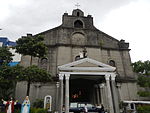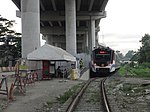Caloocan

Caloocan, officially the City of Caloocan (Filipino: Lungsod ng Caloocan; IPA: [kalɔʔokan]), is a 1st class highly urbanized city in Metropolitan Manila, Philippines. According to the 2020 census, it has a population of 1,661,584 people making it the fourth-most populous city in the Philippines. Caloocan is divided into two geographical locations with a total combined area of 5,333.40 hectares (13,179.1 acres). It was formerly part of the Province of Rizal of the Philippines' Southern Luzon Region. It comprises what is known as the CAMANAVA area along with cities Malabon, Navotas and Valenzuela. South Caloocan is bordered by Manila, Quezon City, Malabon, Navotas and Valenzuela. Presence of commercial and industrial activities combined with residential areas make it a highly urbanized central business district and a major urban center in the Northern District of Metropolitan Manila. North Caloocan shares its border with Quezon City and Valenzuela, Marilao, Meycauayan and San Jose del Monte in the province of Bulacan, and Rodriguez in the province of Rizal. It is composed of mostly residential subdivisions and extensive resettlement areas with scattered distribution of industrial estates mostly within road transit points and intersections.
Excerpt from the Wikipedia article Caloocan (License: CC BY-SA 3.0, Authors, Images).Caloocan
Schönburg, Wethautal
Geographical coordinates (GPS) Address Nearby Places Show on map
Geographical coordinates (GPS)
| Latitude | Longitude |
|---|---|
| N 14.65 ° | E 120.97 ° |
Address
Burg Schönburg
Schönburg
06618 Wethautal
Sachsen-Anhalt, Deutschland
Open on Google Maps








